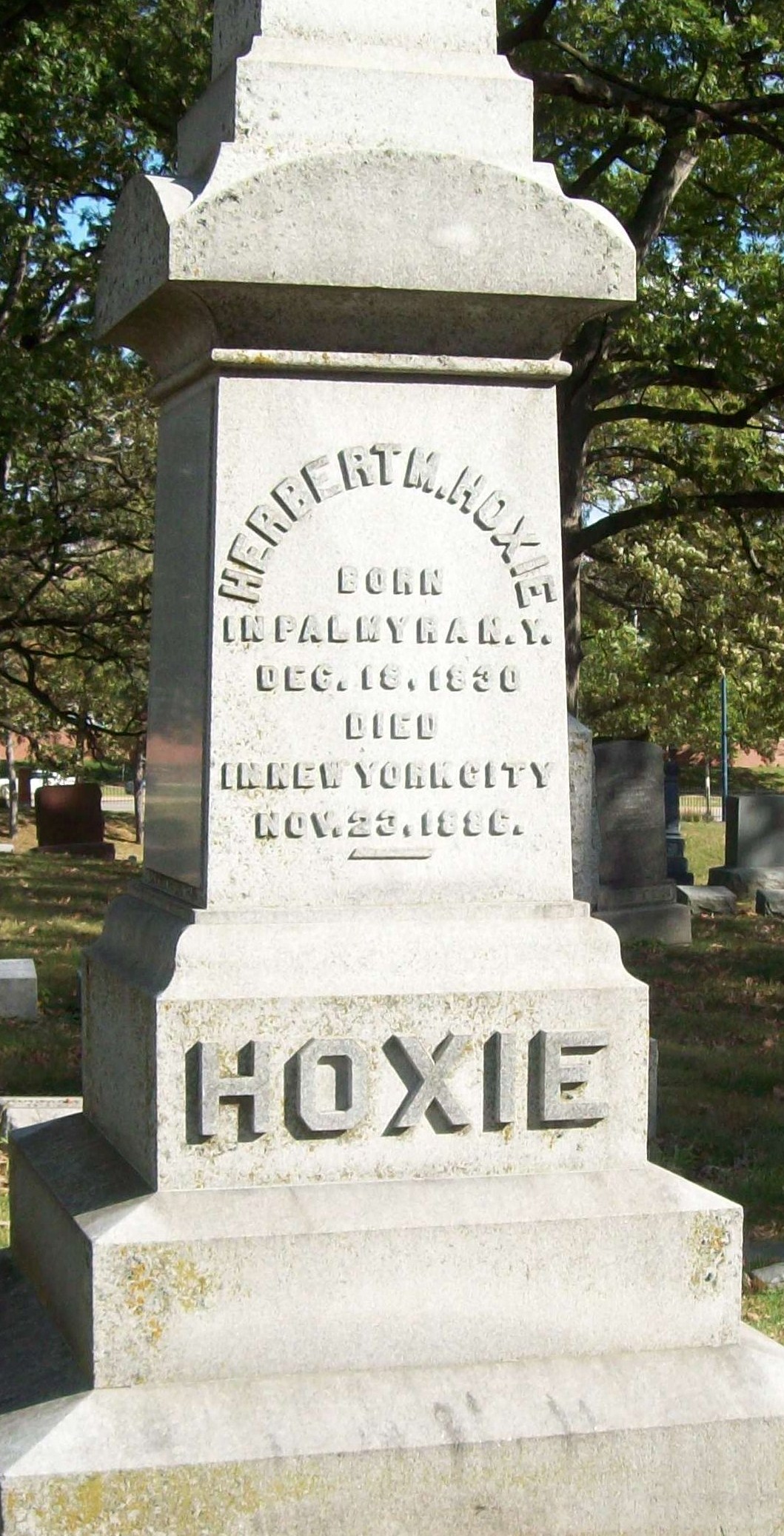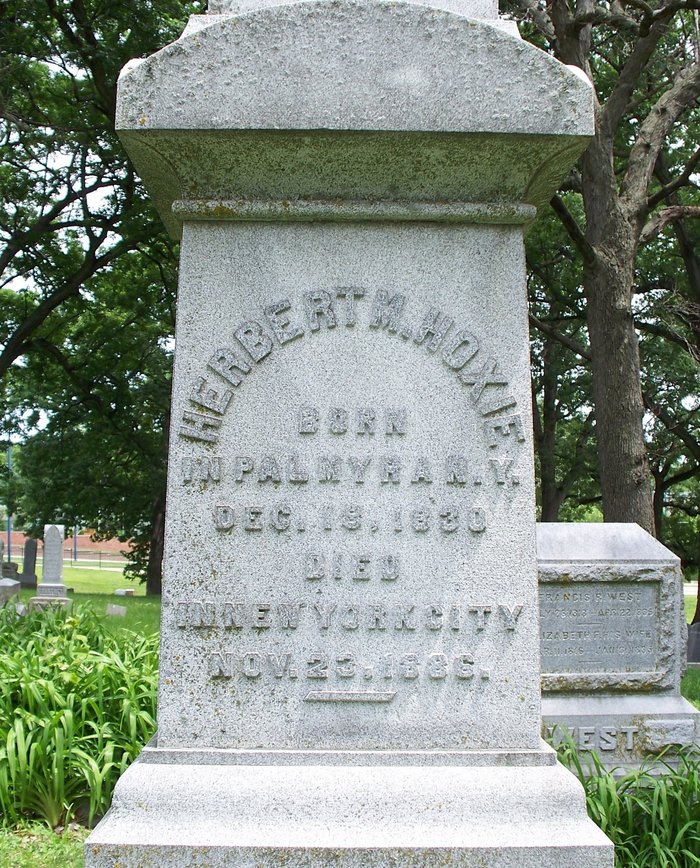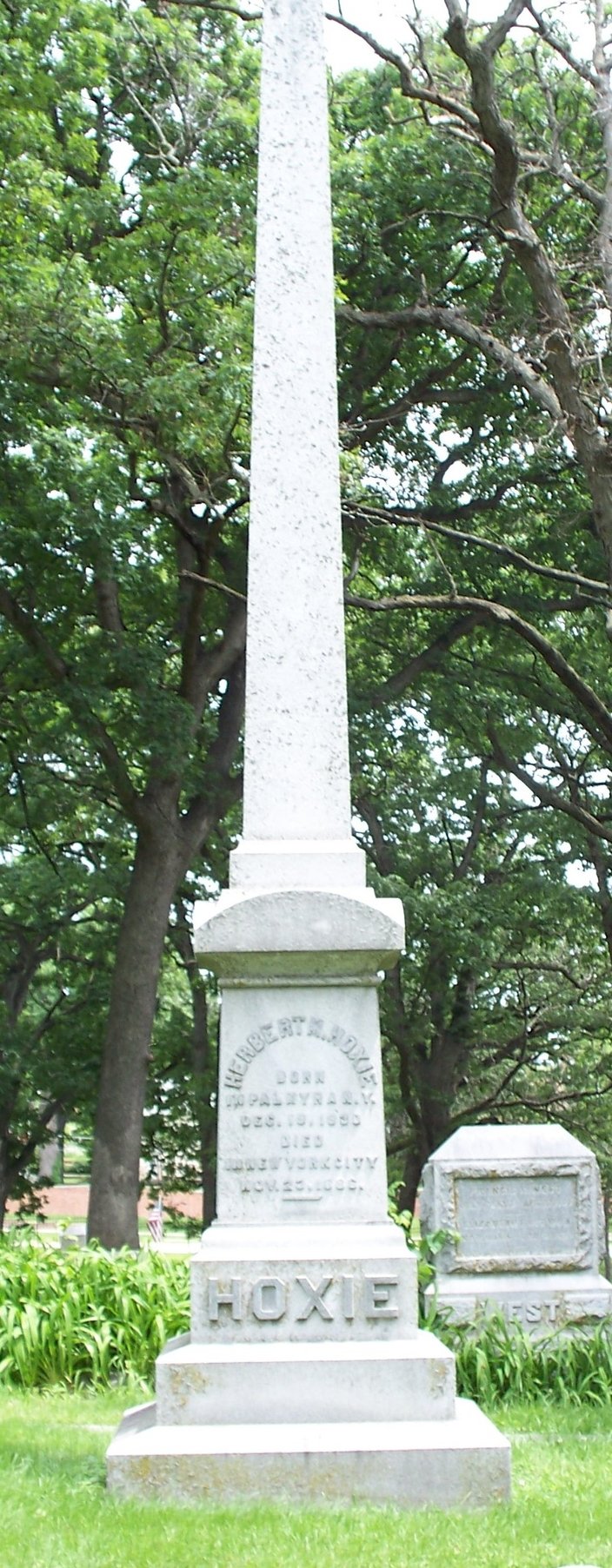The New York Times, New York, New York, New York, 24 Nov 1886.
Herbert Mallory Hoxie, of St. Louis, First Vice-President and General Manager of the Southwestern, system of railroads, died at 2 o'clock yesterday morning at the Bradbury apartment house, Broadway and Fortieth-street. In railroad circles everywhere he was considered a man of unusual ability in his profession, and it is universally conceded that to his management, foresight, and energy was due the decisive victory won by his company last Spring in the strike that existed over 5,000 miles of road.
Mr. Hoxie was a native of this State, having been born at Palmyra, Wayne County, on Dec. 18, 1830. When Mr. Hoxie was only 5 years old his parents moved to Buffalo, but remained there only two years, settling at Des Moines, Iowa, when on the site of the present city there stood a fort and a trading post. There he assisted his father in farming and in trading with the Indians. He was smitten with the gold fever in 1850, and traveled overland to California, where, however, he failed to make a fortune. Returning to Iowa, he became interested in farming once more, this time with the Hon. Thomas Mitchell, whose niece he afterward married. He became actively engaged in politics, and just before the breaking out of the war was made Chairman of the Republican State Committee. At the beginning or the war he was appointed United States Marshal of Iowa.
He was General Superintendent of the Union Pacific Railroad while it was under construction. The vast supplies needed in the construction of the road were collected and forwarded under his personal supervision. He was always at the front, invariably accompanied by his wife. Upon the completion of the road Mr. Hoxie resigned his position and rested for a year. In the latter part of 1870, he was appointed General Superintendent of the International Railroad, Texas, of which John S. Barnes was President. He became General Manager of the International and Great Northern Railroad, after the two roads had been consolidated in 1872. In 1880 Col. Thomas A. Scott selected him as General Manager of the Texas and Pacific Railroad, and a year later he was given the same position over the Iron Mountain, St. Louis and Southern and all the roads in Texas controlled by Mr. Gould. In 1883, when the Wabash Road was annexed to the system, Mr. Hoxie was elected First Vice-President of that corporation, as well as of the Gould Southwestern system, and in 1885, upon the resignation of Capt. R. S. Hayes, he was made General Manager of the system. Under his management it has been extended as well as improved.
Soon after the conclusion of the strike on the system he was compelled to relinquish his work and come East to secure health and rest. He was accompanied by Mrs. Hoxie. He spent the greater part of the Summer at Saratoga, and after a trip through portions of Ontario and Quebec and a visit to the White Mountains returned to this city on Sept. 10. His physical condition had not improved, and nine weeks ago yesterday he submitted to a surgical oneratipn by which several calculi were removed from the bladder. A second operation was performed four weeks ago, but was of no avail. He was unable to assimilate the little food he swallowed and simply wasted away. He suffered a great deal of pain, but bore it without a murmur. His wife and nurse were with him when he died. His body will be taken to Des Moines to-night and buried there on Friday afternoon, next the grave of his boy, who died at the age of 3 years. He was the only child. The body will be accompanied by a number of personal friends, by Mrs. Hoxie, Mrs. Chester Thorne, the adopted daughter of Mr. and Mrs. Hoxie; Mr. Thorne, and Miss Stafford. Socially Mr. Hoxie was a great favorite, though he gave nearly all his time to business.
The New York Times, New York, New York, New York, 27 Nov 1886.
DES MOINES, Iowa, Nov. 26.—The funeral of the late H. M. Hoxie occurred here to-day. A special train of six cars on the Rock Island Railroad brought the body and the funeral party from Chicago, reaching here about noon. In the party were representatives of all the leading railroads entering Chicago. A special train of seven Pullman cars arrived from St. Louis about the same hour, bringing the leading officers of the Missouri Pacific. One or two representatives from every railroad centring at St. Louis and 40 of the leading business men of St. Louis came. The funeral exercises were held at St. Paul's Episcopal Church, and were conducted by the Rev. Dr. Van Antwerp. At the grave the exercises were simple and brief. Mr. Hoxie's remains were buried at the side of his only child, who died in 1861.
The New York Times, New York, New York, New York, 24 Nov 1886.
Herbert Mallory Hoxie, of St. Louis, First Vice-President and General Manager of the Southwestern, system of railroads, died at 2 o'clock yesterday morning at the Bradbury apartment house, Broadway and Fortieth-street. In railroad circles everywhere he was considered a man of unusual ability in his profession, and it is universally conceded that to his management, foresight, and energy was due the decisive victory won by his company last Spring in the strike that existed over 5,000 miles of road.
Mr. Hoxie was a native of this State, having been born at Palmyra, Wayne County, on Dec. 18, 1830. When Mr. Hoxie was only 5 years old his parents moved to Buffalo, but remained there only two years, settling at Des Moines, Iowa, when on the site of the present city there stood a fort and a trading post. There he assisted his father in farming and in trading with the Indians. He was smitten with the gold fever in 1850, and traveled overland to California, where, however, he failed to make a fortune. Returning to Iowa, he became interested in farming once more, this time with the Hon. Thomas Mitchell, whose niece he afterward married. He became actively engaged in politics, and just before the breaking out of the war was made Chairman of the Republican State Committee. At the beginning or the war he was appointed United States Marshal of Iowa.
He was General Superintendent of the Union Pacific Railroad while it was under construction. The vast supplies needed in the construction of the road were collected and forwarded under his personal supervision. He was always at the front, invariably accompanied by his wife. Upon the completion of the road Mr. Hoxie resigned his position and rested for a year. In the latter part of 1870, he was appointed General Superintendent of the International Railroad, Texas, of which John S. Barnes was President. He became General Manager of the International and Great Northern Railroad, after the two roads had been consolidated in 1872. In 1880 Col. Thomas A. Scott selected him as General Manager of the Texas and Pacific Railroad, and a year later he was given the same position over the Iron Mountain, St. Louis and Southern and all the roads in Texas controlled by Mr. Gould. In 1883, when the Wabash Road was annexed to the system, Mr. Hoxie was elected First Vice-President of that corporation, as well as of the Gould Southwestern system, and in 1885, upon the resignation of Capt. R. S. Hayes, he was made General Manager of the system. Under his management it has been extended as well as improved.
Soon after the conclusion of the strike on the system he was compelled to relinquish his work and come East to secure health and rest. He was accompanied by Mrs. Hoxie. He spent the greater part of the Summer at Saratoga, and after a trip through portions of Ontario and Quebec and a visit to the White Mountains returned to this city on Sept. 10. His physical condition had not improved, and nine weeks ago yesterday he submitted to a surgical oneratipn by which several calculi were removed from the bladder. A second operation was performed four weeks ago, but was of no avail. He was unable to assimilate the little food he swallowed and simply wasted away. He suffered a great deal of pain, but bore it without a murmur. His wife and nurse were with him when he died. His body will be taken to Des Moines to-night and buried there on Friday afternoon, next the grave of his boy, who died at the age of 3 years. He was the only child. The body will be accompanied by a number of personal friends, by Mrs. Hoxie, Mrs. Chester Thorne, the adopted daughter of Mr. and Mrs. Hoxie; Mr. Thorne, and Miss Stafford. Socially Mr. Hoxie was a great favorite, though he gave nearly all his time to business.
The New York Times, New York, New York, New York, 27 Nov 1886.
DES MOINES, Iowa, Nov. 26.—The funeral of the late H. M. Hoxie occurred here to-day. A special train of six cars on the Rock Island Railroad brought the body and the funeral party from Chicago, reaching here about noon. In the party were representatives of all the leading railroads entering Chicago. A special train of seven Pullman cars arrived from St. Louis about the same hour, bringing the leading officers of the Missouri Pacific. One or two representatives from every railroad centring at St. Louis and 40 of the leading business men of St. Louis came. The funeral exercises were held at St. Paul's Episcopal Church, and were conducted by the Rev. Dr. Van Antwerp. At the grave the exercises were simple and brief. Mr. Hoxie's remains were buried at the side of his only child, who died in 1861.
Family Members
Advertisement
Advertisement

























